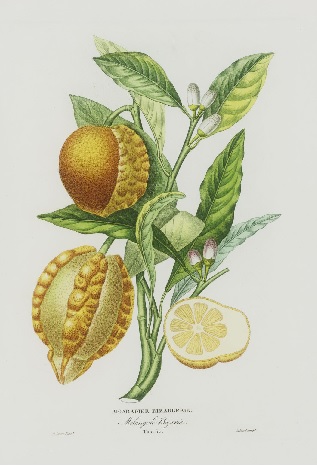Copyright © 2015 by Christ EDV Service | All Rights reserved | E-Mail: bm@zitrus.info
Some important publications on the systematics of citrus plants were published in France at the beginning of the 19th century. They contained detailed descriptions and mostly also color illustrations of leaves and fruits of the bizzarria.
With a clear botanical classification of the Bizzarria the monograph Traité du Citrus by Georges Gallesio was published in 1811. As a basis of Gallesio's classification served a theory, the so called Theorie de la reproduction vegetale. Gallesio recognized that hybrids of different species can arise through outcross pollination. He explained the formation of monstrosities, such as the Bizzarria, with the irregular and uneven mixing of the components in the act of fecundation. He wrote: "The hermaphrodite orange is owing to fecundation; it is a fact witch results from ist forms, from the nature of its productions and from all phenomena of its existence". As bastard of a sour orange he named the Bizzarria as Citrus aurantium indicum limo-citratum, folio et fructu mixto.
The monograph by Antoine Risso and A. Poiteau, Histoire naturelle of the orangers, which was published for the first time in 1818, was to become a standard work for the classification of citrus plants. The chapter on Bizzarria begins with the remark: "Here is the most amazing and strangest tree in the whole plant world." The term Bigaradier Bizarrerie assigns the Bizzaria to the sour orange and corresponds thereby to Gallesio's classification. . The colored print shows two clearly stylized mixed fruits on a branch with white and violet flowers, as well as several differently shaped leaves. It was based on a drawing by A. Poiteau.
The monograph by Antoine Risso and A. Poiteau, Histoire naturelle of the orangers, which was published for the first time in 1818, was to become a standard work for the classification of citrus plants. The chapter on Bizzarria begins with the remark: "Here is the most amazing and strangest tree in the whole plant world." The term Bigaradier Bizarrerie assigns the Bizzaria to the sour orange and corresponds thereby to Gallesio's classification. . The colored print shows two clearly stylized mixed fruits on a branch with white and violet flowers, as well as several differently shaped leaves. It was based on a drawing by A. Poiteau.

Risso presumed that, besides the Florentine Bizzarria, there had been or still existed other such plants. He referred to a fruit from Naples, described by Battista Ferrari in 1646, on mixed fruits of up to five different types of citrus in the gardens of the Duke of Orleans during his reign (1715-1723), and a citrus called Arancio del Roberti Bizarro, already mentioned in 1644 in Italy. He proposed to collect and plant cultivars of Bizzarria plants from different locations in order to identify their differences and similarities.
The Bizzarria of Florence